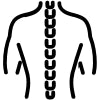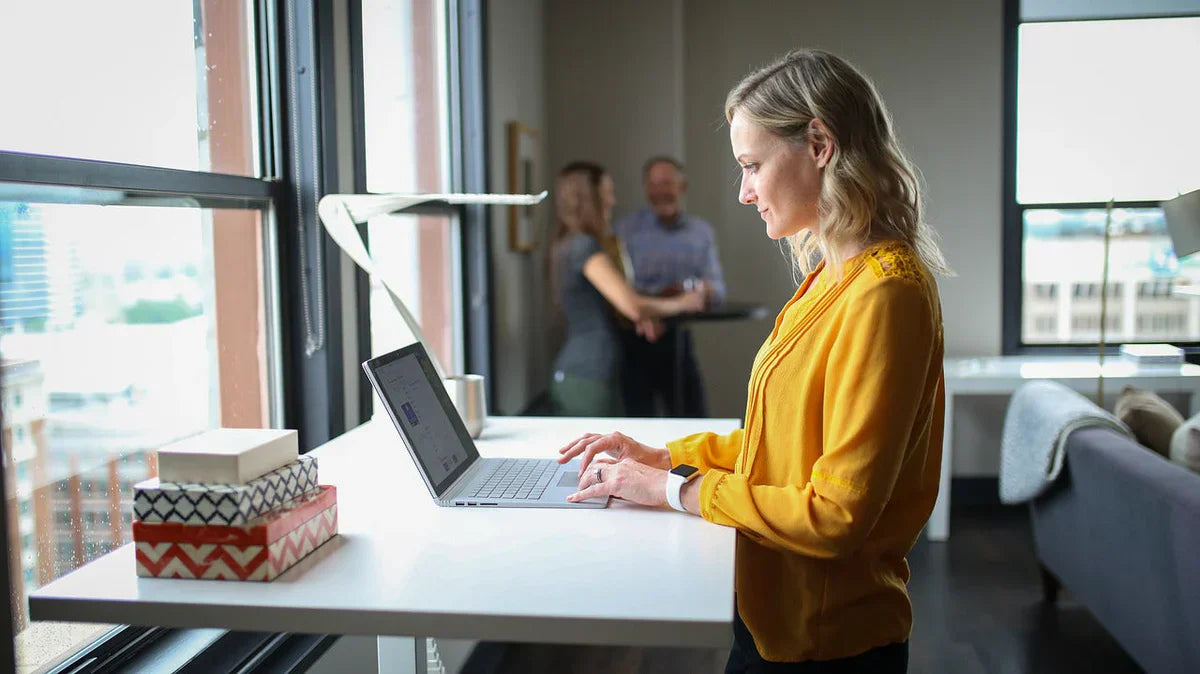What if you could get rid of your back pain and be more productive at work all at once? The solution is easier than you might think: work from a standing position. As simple as it is, this habit can completely transform your work life—reducing your back pain, combatting the harmful effects of physical inactivity on your health, and helping you stay more active. Read on to learn everything you need to know about how to stand as you work and what it can do for you.
The Benefits of Standing While Working
Standing when you work reduces back pain, improves circulation, increases productivity, and helps you stay active during the workday.
Reduces Back Pain
Standing when you work allows you to significantly lessen the back pain that often results from long hours of sitting at a desk. Using a standing desk allows you to alternate between sitting and standing positions throughout the day. Shifting positions is excellent for reducing pressure on the spinal column, relieving back pain and tension while keeping you active during your workday.
Improves Circulation
After sitting for many hours at your desk, your legs may feel heavy. You may even develop varicose veins. Standing while you work helps you stay in constant activity, stimulating your circulation while promoting a healthier rate of blood flow back to your heart. These changes don’t just improve leg health, but help you feel better generally.
Increases Productivity
Working from a standing position can also make you more productive at work. Standing helps you feel more focused, more alert, and more engaged. It also helps ward off the fatigue and loss of focus that often strike after hours of sitting at a desk. Changing positions can even make you more creative and improve your problem-solving abilities.
Keeps You Active at Work
Working at a standing desk helps you stay active all day long. You can also do simple exercises and stretches at your standing desk to live a healthier, more active lifestyle and get in better shape.
If you want to learn more about how to discreetly work out at your desk, or if you’re curious about exercises or stretches you can do at work, check out our articles:
- 12 Stretches You Can Do at Your Desk to Relieve Stress and Muscle Tension
- How to Work Out at Your Desk Without Anyone Noticing
- 10 Easy Ball Seat Exercises to Keep You Active at Work
Working while standing up has countless benefits for your health, well-being, and work performance. By making this practice part of your daily routine, you can improve your posture, circulation, and productivity and stay active all day long.
Choosing a Standing Desk

The Types of Standing Desks
There are two main types of standing desks: manual and electric. Knowing what differentiates them will help you pick the option that’s best for you. Manual standing desks use a hand-crank system or levers to adjust the height. These desks are less expensive, but also less practical, than electric standing desks. For the latter desks, all you have to do to adjust the height is press a button. Electric desks can be pricier, but they are also easier to use. There are also hybrid desks that combine certain aspects of both manual and electric standing desks.
Ergonomics and Adjustability
Your standing desk should be both ergonomic and adjustable. First, make sure that your desk can be adjusted to a height that’s appropriate for your height and the height of your desk chair. Your desk should allow you to work comfortably from both sitting and standing positions.
We recommend choosing an electric or hybrid standing desk, since you can more easily change the height. Desks with mechanisms that allow you to lock or save your chosen position are additionally beneficial. Adjusting the height of your standing desk should be as effortless as possible so you can alternate between sitting and standing throughout your work day.
Material and Durability
The material used to create your standing desk matters. We recommend choosing a standing desk made with strong, long-lasting materials like wood or metal, which will give it a longer lifespan. Check the quality, too, of the other components of your desk, like its levers, cranks, legs, and work surfaces. A good standing desk should be resistant—it shouldn’t break down or deform with minimal use.
Check the reviews from former buyers and the warranties that the manufacturer offers before buying so you can feel more confident in your choice.
To choose the right standing desk for you, you should take into account the type of desk, its ergonomics, its adjustability, and the quality and durability of the materials that it’s made of.
Changing the Height of Your Desk
Whether you’re standing up or sitting down, your desk should be at a height that makes your posture better, not worse.
How High Should Your Desk Be?
When you work standing up, your desk’s height should allow your elbows to form a 90° angle. When you’re sitting, your feet should be flat on the ground (or on a footrest) and your knees should similarly be at a 90° angle. Adjusting the height of your desk so that it’s right for your height and your personal preferences will help prevent poor posture and muscle tension.
Dynamic Posture—Both Sitting and Standing
Regularly switching between sitting and standing can help you prevent the health problems and back pain that are caused by remaining too long in the same position. You can use accessories like lumbar cushions to support your lower back and adjust the height of your chair so that it’s as comfortable as possible for you. When you work from a standing position, doing a bit of light movement or swaying can improve your circulation and reduce fatigue. You can also take small steps to stave off stiffness and stay active while working.
To learn more about the importance of posture, read our article: The Power of Posture: How to Stay Pain-Free at Work.
Using an Active Seat

Using an active seat like the Bloon ball seat can make an enormous difference in your posture and comfort as you work. Active seats promote light movement and better posture, all while strengthening your abdominal and back muscles as you sit. Active seats offer a multitude of health benefits—they improve posture, reduce back pain, increase productivity, prevent musculoskeletal disorders, and improve your overall well-being.
We recommend the Bloon active seat. This ergonomic ball chair can be used at your desk and fits perfectly into any kind of decor. You can even do exercises on it. To learn more, read our article: The Bloon Active Seat: An Ergonomic Chair That Keeps You Moving As You Sit.
By following these best practices for dynamic posture and tips for adjusting the height of your desk, you’ll reap the benefits of both greater comfort and better health at work.
The best way of improving your productivity, health, and comfort at work is to set up an ergonomic workspace that includes both a standing desk and an active seat.
Tips for a Successful Transition
Transitioning from a classic desk to a standing desk is an excellent way to improve your health in the office. It does, however, require a bit of preparation. Here are some of our tips for making the switch easier.
Take It Slow
We recommend standing as you work for only short periods of 10 to 30 minutes every hour at first, which helps your body get used to working from a standing position. Once you’ve grown accustomed to this new way of working, you can gradually increase the time you spend standing. This lets your body adapt without too much fatigue or soreness.
Check Your Posture
The goal of a standing desk and an active or dynamic seat is to naturally improve your posture. Whether you’re sitting or standing, make sure that your screen is at eye level, that your elbows are at 90° angles, and that your feet are resting comfortably on the ground or on a footrest. Practice dynamic posture by shifting regularly between sitting and standing positions.
Take Active Breaks
Use your transition into standing more as an opportunity to also cultivate other healthy habits—like doing more physical activity at work. Taking regular breaks to walk, stretch, or do light exercises helps prevent fatigue and keeps you more energetic throughout the day. Active breaks can also improve your focus and productivity.
If you’re looking for exercises you can do with your Bloon active seat, check out our article: 10 Easy Ball Seat Exercises to Keep You Active at Work.
Listen to Your Body
Listen to your body as you make the transition from a sitting desk to a standing desk. If you feel any pain or discomfort, don’t hesitate to adjust the height of your desk or the length of your standing sessions. Don’t forget that there’s no “one size fits all” solution—find the configuration and rhythm that suits you best.
Standing as you work comes with numerous benefits for your well-being. It improves your productivity, posture, and circulation all while reducing your back pain. Best of all, it’s easy. If you want to incorporate standing into your workday, all you have to do is add a standing desk to your workspace and begin gradually transitioning to using it!
FAQ: Standing Desks
What Are the Benefits of Standing When I Work?
Working from a standing position has a number of benefits. It reduces back pain, improves circulation, increases productivity, and keeps you active at work.
How Do I Choose a Standing Desk?
When you go to choose your standing desk, you should take into account: the type of desk (manual, electric, or pneumatic), its ergonomics, how easy it is to adjust the height, the materials it’s made from, and its durability. We recommend choosing a desk that is easily adjustable and that matches your needs in terms of how it feels and fits into your workspace.
How Do I Know How High It Should Be?
Your elbows should form a 90° angle with your desk whether you’re working from a sitting or standing position. The screen of your computer should be at eye level to prevent neck tension. When sitting, your feet should be flat on the ground and your knees should also form a 90° angle.
How Long Should I Stand While Working Each Day?
We recommend starting with short sessions of 30 to 60 minutes, then alternating between sitting and standing positions every hour. The long-term goal is to spend 2 to 4 hours of your workday standing up. Throughout this process, though, you should listen to your body and adjust the duration depending on how you feel.
What Ergonomic Equipment Is Useful for a Standing Desk?
The best ergonomic equipment to use with a standing desk are an active seat, an anti-fatigue mat to reduce pressure on your feet and legs, a footrest to support your legs when you’re sitting, and an adjustable screen to keep your computer screen at eye level.
Is Working Standing Up Safe for Everyone?
No, not everyone should work standing up. People with circulatory problems, joint pain, or specific medical conditions should consult a healthcare professional before changing their work routine.
What Are the Differences Between Manuel, Electric, and Pneumatic Standing Desks?
The difference is how you adjust the height. The height of a manual desk can be adjusted with the help of a hand-crank or lever. Manual desks are a less expensive option, but they require physical effort to change their position. An electronic standing desk makes changing heights effortless—all you have to do is press a button. A pneumatic desk uses a compressed air system to adjust the height. It’s faster than a manual desk, but it also doesn’t require electricity like electric desks do.
Where Can I Find A High-Quality Standing Desk?
You can find high-quality standing desks in stores that specialize in office furniture, through online retailers like Amazon or Ikea, or directly through manufacturers like Fully, Uplift Desk, or VariDesk. We recommend first reading customer reviews and checking the manufacturers’ warranties before buying.
Is It Healthy to Work Standing Up?
Yes, standing as you work has a number of advantages for your health! It reduces the health risks linked to physical inactivity, improves posture, and makes you more productive. However, it’s also best not to stand for the entire day. Alternating between standing and sitting positions, combined with adding in regular movement, is the key to maximizing the health benefits you get from standing.











